One of the most attractive aspects of collecting jewelry is the connection to the past that each piece holds. Sometimes those associations are difficult to trace and even harder to imagine. But within a subcategory collectors have nicknamed “sweetheart jewelry,” the link to history is immediately evident and sometimes soul stirring.
If you haven’t heard of this type of jewelry before, the definition is endearing. Basically, sweetheart pieces are sentimental items that were worn by women waiting for the return of enlisted service men during wartime. Whether that special someone was a wife, girlfriend, or mother, many women owned and wore this expressive jewelry as a way to show support for their loved ones.
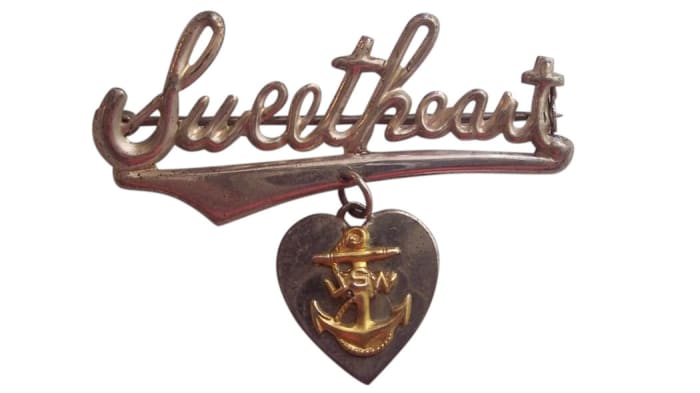
U.S. Navy sweetheart pin from World War II in sterling silver. Value: $30
Image courtesy RubyLane.com
Some pieces from World War I surface occasionally but these items that encompass nostalgia, sentimentality, and patriotism mainly date to the World War II era. Examples include brooches, bracelets, and necklaces made by major manufacturers like Trifari, Coro, Boucher, and Accessocraft that were sold in retail stores. Others were hand crafted by soldiers serving in the trenches as one type of “trench art,” and then shipped back home. Collectors of both jewelry and militaria seek all types of sweetheart jewelry items today.
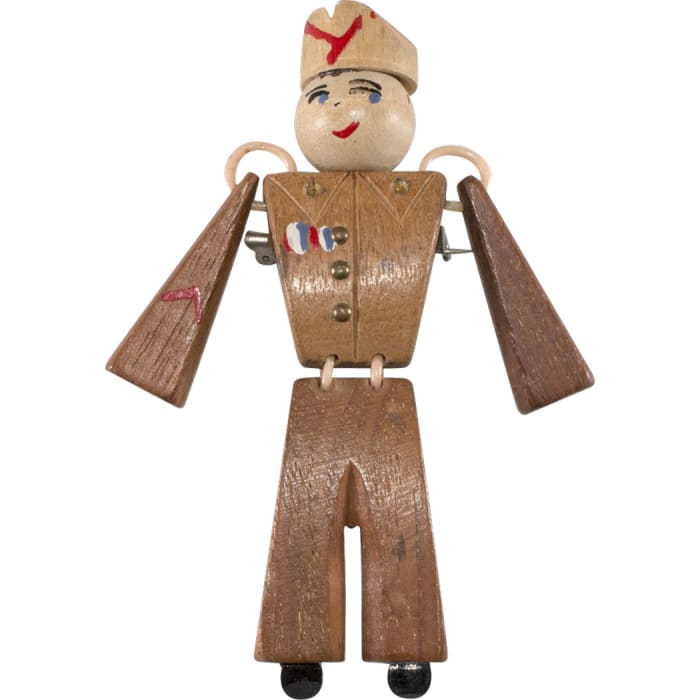
Soldier brooch made of wood with articulated arms and hand painted accents, 1940s. Value: $75-$100
Image courtesy Jay B. Siegel
More About The Jewelry
You might be wondering what distinguishes more generic patriotic jewelry donned during the 1940s from sweetheart pieces. In a few instances the lines are most definitely blurred. Take pins reading “Remember Pearl Harbor” or “V for Victory” pins. While these are usually lumped in with sweetheart jewelry, they could have been purchased and worn by anyone during the war years. Then you have American flags and eagles decorated with rhinestones or red, white and blue enameling along with jewelry saluting partnerships among allies of the United States. A multitude of jewelry pieces were made and worn to show patriotism from the late 1930s until the war ended in 1945.
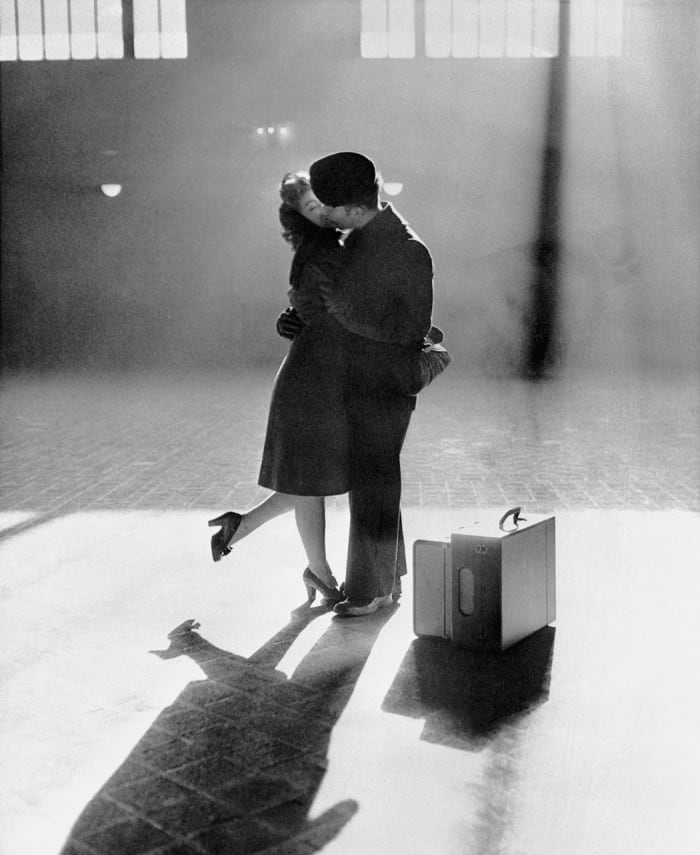
More than 16 million men and women served in the US Armed Forces during World War II. Here, Mary Rae Bingham kisses her boyfriend, Gordon Kiester, at Michigan Central Station in Detroit, December 1944.
Photo courtesy Bettman/Getty Images
While anyone might accessorize with a more generic patriotic piece, sweetheart jewelry reflects a deeper connection by actually including a military theme or specific sweetheart wording. Some of these are more overt like a heart pendant reading “Sweetheart” or a brooch in a in the shape of a solider or sailor. Others have military symbolism such as anchors for a navy connection or crossed rifles representing infantry soldiers as part of the overall design. Every branch of military service is represented in sweetheart jewelry. Some even reflect specific units like the Navy’s Seabees construction battalion and the WASP (Women’s Airforce Service Pilot) program. These types are a bit harder to find than other types of sweetheart pieces but well worth the effort to devoted collectors.
The lack of available materials, whether due to rationing on the home front or scarcity in the field, also inspired costume jewelry makers to get creative. Gold- and silver-plated pieces were produced while base metal alloys were readily available prior to 1943 in the United States. Sterling silver was widely used by major jewelry companies thereafter. Manufacturers also employed wood, plastics like Bakelite and Lucite, and all types of natural materials in sweetheart designs. Trench art pieces were made from anything and everything available including coins from around the globe, various types of shell, and leather.
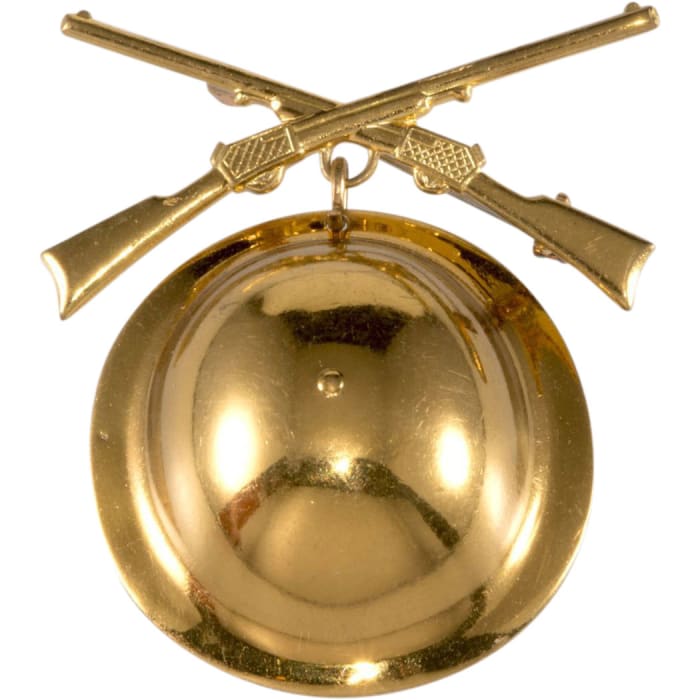
Brass brooch with old-style ‘doughboy’ soldier’s helmet and crossed infantry rifles, late 1930s. Value: $35-$55
Image courtesy Jay B. Siegel
The sweetheart pieces that are the most personal, however, include a name as part of the design. Holding a piece and imaging the “Betty” or “Doris” who originally received the item takes the connection to a deeper level and may bring to mind a family member who lived through this period.
Even more heart tugging are the pieces bearing stars. These were worn by mothers indicating they had one or more children serving in the military. While these are often found on pins with one, two or three stars as part of the design, many pendants, charms, and bracelets were also made with this profound motif. Examples with four or more stars are decidedly harder to come by than those with up to three.
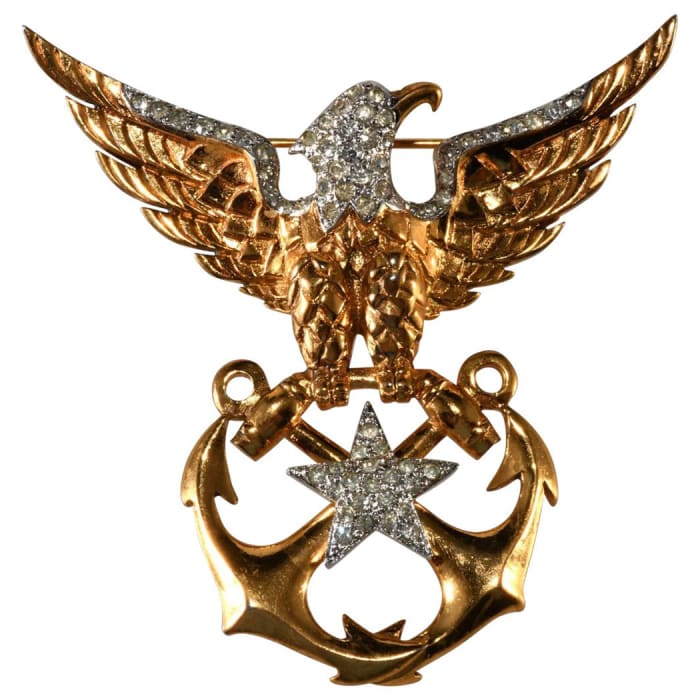
Boucher gold-plated American eagle with crossed anchors and rhinestone accents, early 1940s. Value: $275-$325.
Image courtesy Jay B. Siegel
Beyond the nostalgia associated, one of the fun aspects of ferreting out sweetheart jewelry for a collection is finding offerings available in all price ranges including high-end fine jewelry. While you won’t locate them for sale often, every now and then a platinum sweetheart piece encrusted with the patriotic combo of rubies, diamonds and sapphires surface selling for thousands. Some rare Bakelite pieces can top $1,000 as well.
The other end of the spectrum provides a bevy of sweetheart pieces most anyone can afford. This includes single puffy heart charms and small brooches that can be purchased for $20 or less. Most will cost a bit more but there are still numerous options available in the under $100 price range.
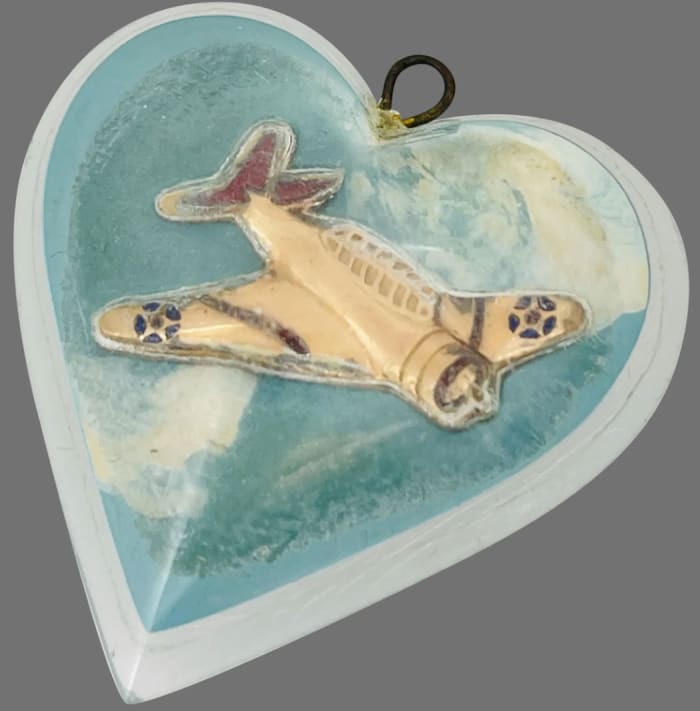
A unique piece of sweetheart jewelry from World War II depicting a gold airplane against a blue sky with white clouds, all inset in a thick lucite heart-shaped piece.
Image courtesy RubyLane.com
Sweetheart Research
The category of sweetheart collectibles actually goes far beyond jewelry. Other items sent home to loved ones include objects ranging from useful powder compacts to decorative pillow covers. The sentiment combining wartime patriotism with a desire to keep the home fires burning is the same, however.
If you want to learn more about the breadth of this topic, picking up a copy of Sweetheart Jewelry and Collectibles by Nick Snider is a great point of departure. Snider’s second book titled Antique Sweetheart Jewelry also covers a wide variety of related adornment and some collectibles. The first one is recommended, and the second one augments the topic for further learning. These titles are both available from the publisher at SchifferBooks.com.
You May Also Like:
Lady Head Vases: 10 Things You Didn’t Know









